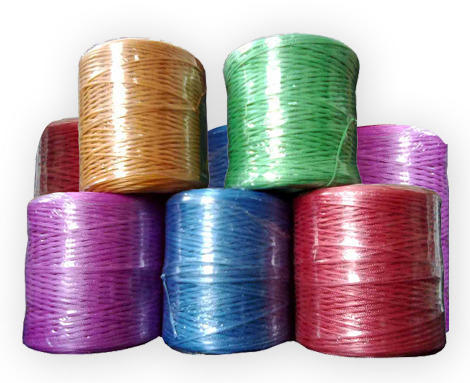What is Rope/Sutli?
“Rope/Sutli is a type of cordage made from natural or synthetic fibers that are twisted or braided together to form a strong and durable length of rope. In India and some other parts of South Asia, the term "sutli" is commonly used to refer to a type of string or cord that is often made from jute fibers and is commonly used for packaging, tying bundles, and other similar purposes. Sutli can also be made from other materials such as cotton or hemp, and it comes in various thicknesses and lengths depending on the intended use. Overall, ropes and sutli are versatile materials that have a wide range of practical applications in industries such as construction, agriculture, and shipping, as well as in everyday life.”
History of Rope/Sutli in Brief Below:
The history of rope and sutli dates back to ancient times. Humans have been using ropes and cords made from natural materials such as plant fibers, animal hair, and sinew for thousands of years. The earliest evidence of rope-making dates back to prehistoric times, where archaeologists have found fragments of rope made from twisted grass and other plant fibers.
In ancient times, ropes were used for a variety of purposes, such as hunting, fishing, and transportation. The ancient Egyptians, for example, used ropes made from papyrus to build boats and construct buildings. The Greeks and Romans used ropes made from hemp and other fibers to rig their ships and construct large structures such as the Colosseum.
As technology advanced, new materials such as cotton, flax, and synthetic fibers were developed, which made rope and sutli stronger and more durable. With the rise of the Industrial Revolution, the demand for rope increased as it was used in various industries such as shipping, construction, and mining.
In India, the use of sutli made from jute fibers became popular during the British colonial era, where it was used for a variety of purposes such as packaging, binding, and as a raw material for handicrafts. Today, rope and sutli continue to be widely used in various industries and for everyday purposes around the world.
Making of Rope/Sutli in Brief Below:
The process of making rope/sutli typically involves twisting or braiding together strands of fibers to create a strong and durable cord. The specific process and materials used may vary depending on the type of rope/sutli being made and its intended use, but the general steps are as follows:
Fiber selection: The first step is to select the fibers that will be used to make the rope/sutli. Common natural fibers used for rope-making include hemp, jute, cotton, sisal, and manila. Synthetic fibers such as nylon, polyester, and polypropylene are also commonly used.
Fiber preparation: Once the fibers are selected, they may need to be cleaned, sorted, and combed to remove any impurities and ensure uniformity in size and texture.
Twisting/Braiding: The next step is to twist or braid together the fibers to create the rope/sutli. This is typically done using a spinning wheel or a braiding machine, which twists or weaves the fibers together in a continuous motion. The number of strands and the direction of the twist/braid can also affect the strength and durability of the rope/sutli.
Finishing: After the rope/sutli has been twisted or braided, it may be coated with wax or other materials to improve its resistance to water, abrasion, and UV light. The rope/sutli may also be cut to the desired length and have the ends finished with knots or metal fittings for attachment.
Rope/Sutli Benefits
Rope/sutli has a variety of benefits and practical applications, some of which include:
Strength and durability – Rope/sutli is made from strong and durable fibers, which makes it suitable for use in a variety of heavy-duty applications such as lifting, towing, and securing loads.
Versatility – Rope/sutli comes in a wide range of sizes, lengths, and materials, which makes it suitable for a variety of applications in different industries, including shipping, construction, agriculture, and more.
Cost-effective – Rope/sutli is a relatively inexpensive material compared to other options such as metal chains, which makes it a cost-effective solution for many applications.
Lightweight – Rope/sutli is lightweight, which makes it easy to handle and transport. This can be especially useful for applications that require the use of long lengths of rope/sutli.
Eco-friendly – Natural fiber ropes/sutli made from materials such as jute, hemp, and cotton are biodegradable and can be composted at the end of their useful life, making them an environmentally friendly option.


Specifications:
| Diameter : | The diameter of rope is typically measured in millimeters or inches and can range from very thin cordage to several inches thick for heavy-duty applications. |
| Material : | The material used to make the rope can vary widely and can include natural fibers such as cotton, hemp, sisal, or manila, or synthetic fibers such as nylon, polyester, or polypropylene. |
| Construction: | The construction of the rope can also vary and can include twisted, braided, or plaited rope, as well as rope with a core or without a core. |
| Breaking strength : | The breaking strength of rope refers to the amount of force required to break the rope and is typically measured in pounds or kilograms. The breaking strength can vary depending on the type of rope, diameter, and construction. |
| Elongation : | The elongation of rope refers to how much it stretches under load and is typically expressed as a percentage. The elongation can vary depending on the type of rope and the amount of load applied. |
| Abrasion resistance: | Abrasion resistance refers to the ability of the rope to resist wear and damage when rubbed against rough surfaces. The abrasion resistance can vary depending on the type of rope and the materials used. |
| UV resistance: | Some types of rope are treated to resist damage from UV rays, which can cause degradation and weakening over time. |